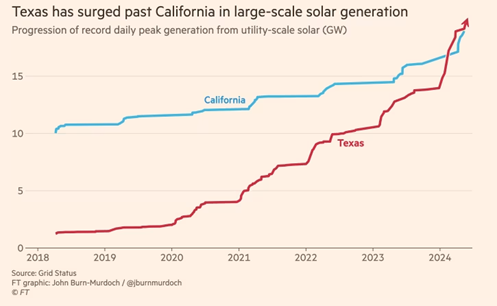Wake Up California: Free Market Energy Solutions Work
While California continues to enact draconian climate laws and regulations that hinder the state’s economy, Texas has taken the lead in driving clean energy production.
New data from energy think tank Ember reveals that after trailing the Golden State for years, Texas is now outpacing California as the nation’s leading producer of power generated from “clean” non-petroleum or coal-based sources, including wind, solar, hydro, nuclear, bioenergy, and other renewables.
 newablGraph from Financial Times.
newablGraph from Financial Times.
A Financial Times article by John Burn-Murdoch highlights how Texas’ business-friendly approach and less burdensome regulatory environment have made the difference.
“The ease of building and connecting new renewable projects in Texas relative to elsewhere has been one of the key reasons for the state’s clean energy boom,” Murdoch writes.
“Its electricity grid operator uses a ‘connect and manage’ model. This assesses new projects based on the essential local requirements needed to connect to the grid instead of carrying out protracted studies into the broader potential ramifications.”
The result of the “connect and manage” model is that new power generation takes about half as long to come online in Texas as elsewhere.

Graph from Utility Dive
Data for 2021 and 2022 shows Texas’ (ERCOT) new power generation well ahead of California’s (CAISO).
Over the past 5 years, Texas has also seen massive increases in its solar generation, skyrocketing from its 2019 levels and surpassing California.

Graph from Financial Times.
Murdoch points out that while Texas is still heavily reliant on gas, in a free market, financial incentives drive innovation, “[Texas’] transition towards clean energy is emblematic of a dynamic that plays out time and time again in climate discussion: economics has a habit of winning out over politics and ideology.”
The benefits of free market incentives for development are even more stark when considering that despite California’s 2021 and 2022 Budget Acts allocating approximately $54 billion over five years towards its climate agenda, it still fell behind Texas in the development of renewables.
In an interview with PBS, Michael Webber – a Professor at the University of Texas focusing on clean energy technology – points out the irony of Texas’ clean energy success, “We didn’t do it for the cleanliness. We didn’t do it for climate change. We did it because it makes us a lot of money for the landowners and saves us a lot of money for the consumers.”
Another driving force for Texas’ success comes from an abundance of workers and entrepreneurs from the oil and gas industries that have experience working in drilling and fracking which has made advances in clean energy possible through geothermal power..
As clean energy and renewable technology continue to develop, some unexpected businesses are playing a major role in innovation and are welcomed in Texas’ pro-business environment.
In contrast, a 2022 Hoover Institution report spotlights California’s declining innovation environment and a massive business exodus driven by excessive regulation and business-killing economic policies. Hardest-hit industries include manufacturing, aerospace, financial services, real estate, chemicals, health care, and high technology. It should come as no surprise that Texas received a significant plurality of California’s business relocations.
California ranks last in the nation when it comes to the number of state regulations, as in, the Golden State has the most: over 403,000 unique regulations according to the 2022 data from the Mercatus Center’s State RegData project, which quantifies state regulatory text. These regulations consist of any regulatory text consisting of the phrases shall, must, may not, prohibited, and required which create legal constraints and obligations.
In comparison, Texas, while nationally still a heavily regulated state, has just over 273,0000 total regulations. On environmental protection and natural resources, Texas has around 45,000 regulations compared to California’s more than 66,000 environmental rules. And none of Texas’ regulatory regimes is as powerful and stifling as the California Environmental Quality Act (CEQA), a 1970 behemoth of legislation that created major barriers to development through environmental impact study requirements.
Edward Ring, Director of Water and Energy Policy at the California Policy Center, identifies in a recent report that the California regulatory environment is driving the state’s economy in the wrong direction. Ring advocates eliminating the private right of action under CEQA which invites endless environmental lawsuits that delay and deter investment in renewables, along with countless other worthy projects.
If California leaders are serious about climate issues and man-made emissions, they must recognize that renewables still struggle to compete with the capacity and efficiency of baseload natural gas or nuclear power generation. This would be the case even if the regulations, permitting processes, and litigation were removed.
Meanwhile, California’s governor and the progressive supermajority in the legislature have passed some of the nation’s most extreme climate legislation, such as prohibiting sales of new small off-road engines used in lawn equipment, or the California Climate Crisis Act, which mandates California achieve net zero greenhouse gas emissions as soon as possible, but no later than 2045. In 2020, Governor Newsom issued an executive order imposing a ban on the sales of all gas-powered passenger vehicles by 2035.
If state lawmakers and regulators continue on the current trajectory, California’s economy will continue to suffer. Gross fiscal mismanagement, driven by overspending on California’s climate agenda, will exacerbate the current $58 billion deficit for the 2024-2025 budget.
California’s leaders must wake up to the reality that their regulatory labyrinth is stifling progress, while Texas is blazing a trail with market-driven solutions. It’s high time for the Golden State to make a U-turn turn toward free market solutions and unleash the state’s innovative potential.
Andrew Davenport is a Policy & Research Associate with California Policy Center.
